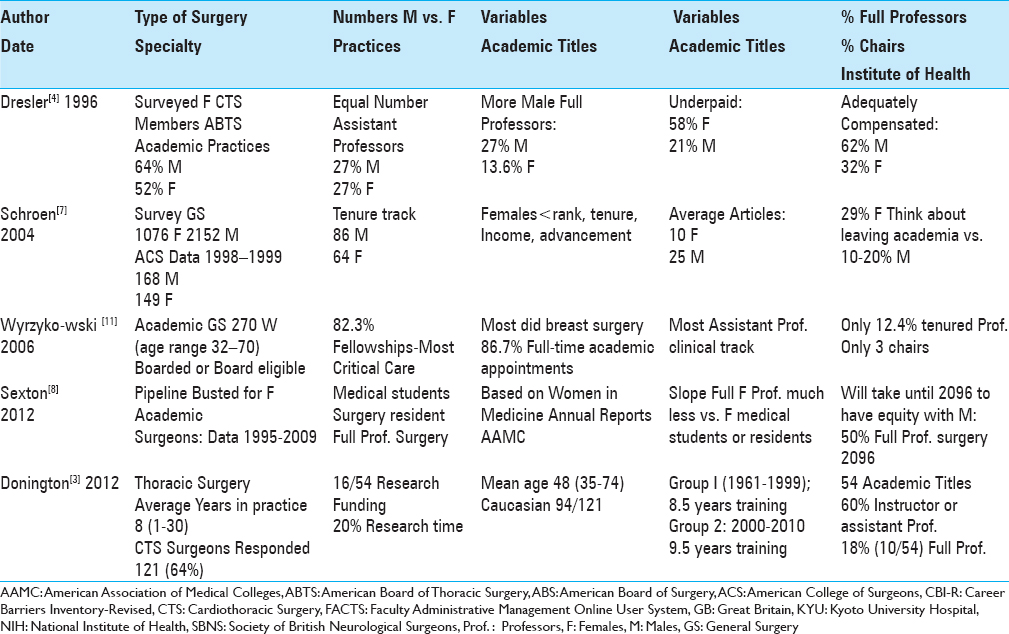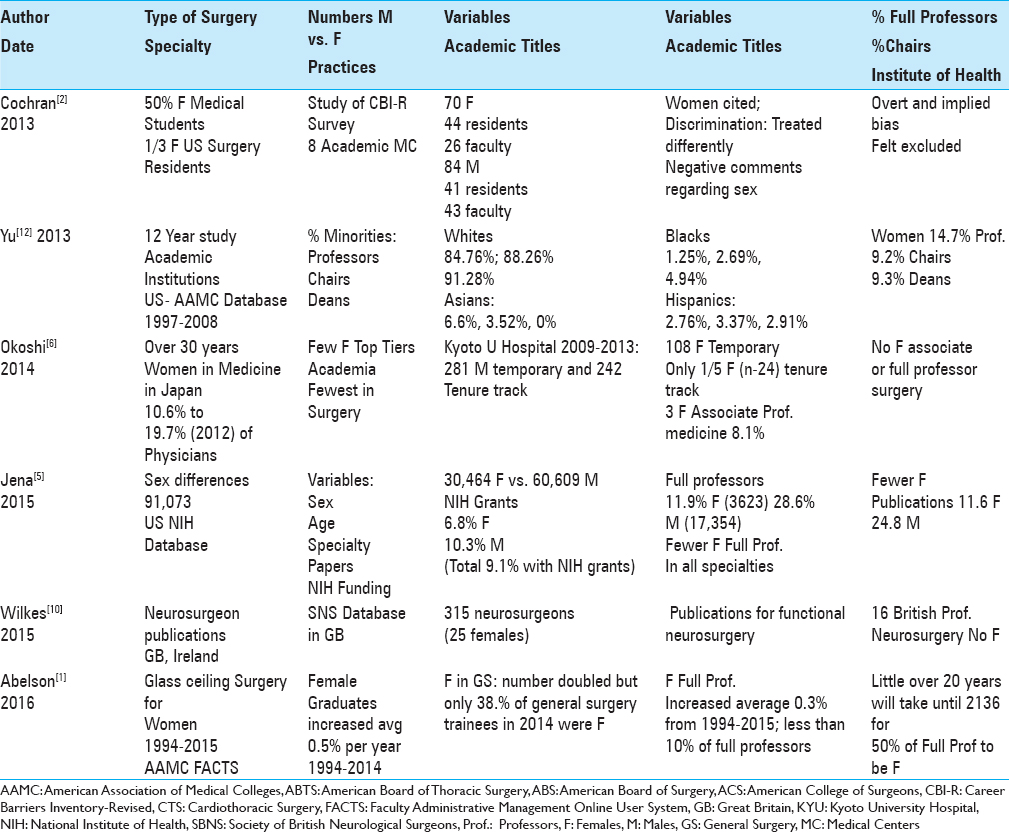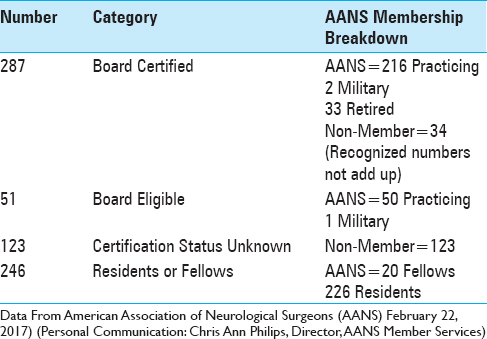- Chief of Neurosurgical Spine/Education, Winthrop University Hospital, Mineola, New York, USA
Correspondence Address:
Nancy E. Epstein
Chief of Neurosurgical Spine/Education, Winthrop University Hospital, Mineola, New York, USA
DOI:10.4103/sni.sni_90_17
Copyright: © 2017 Surgical Neurology International This is an open access article distributed under the terms of the Creative Commons Attribution-NonCommercial-ShareAlike 3.0 License, which allows others to remix, tweak, and build upon the work non-commercially, as long as the author is credited and the new creations are licensed under the identical terms.How to cite this article: Nancy E. Epstein. Discrimination against female surgeons is still alive: Where are the full professorships and chairs of departments?. 26-May-2017;8:93
How to cite this URL: Nancy E. Epstein. Discrimination against female surgeons is still alive: Where are the full professorships and chairs of departments?. 26-May-2017;8:93. Available from: http://surgicalneurologyint.com/surgicalint-articles/discrimination-against-female-surgeons-is-still-alive-where-are-the-full-professorships-and-chairs-of-departments/
Abstract
Background:Although half of all medical students are now and women are increasingly filling surgical residency positions, few ascend the academic ladder to become chairman of their departments, much less full academic professors.
Methods:We queried PubMed to search for the number of women surgeons in different subspecialties, and asked how many were chairman or full academic professors?
Results:Data coming out of largely general or cardiothoracic surgery departments cited no substantial gains for women surgeons over the years; there were few chairmanships or full professorships. In one study of 54 female cardiothoracic surgeons, 60% of academic appointments were at the instructor or assistant professor level; only 18% were full professors. In another study looking at 12-year data from major academic medical institutions in the US, women constituted only 9.2% of chairs, only 14.7% of full professors, and just 9.3% of deans. In a third study, out of 270 female general surgeons, there were only three who were chairman, and just 12.4% were tenured professors. In Great Britain/Ireland, of 315 neurosurgeons (25 females), all 16 full professors were males. Two medical/surgical series speculated it would take until 2096 or 2136 for females to attain 50% of full professorships. The American Association of Neurological Surgery (U.S. 2017; personal communication) showed that of 287 Board-certified female neurosurgeons, there is just one female surgeons chairman.
Conclusions:Few female physicians/surgeons were chairs of departments or full professors at their academic institutions. Do women in medicine/surgery really need to wait until 2136 to achieve equality?
Keywords: Chairman, departments, full new professors, minorities, unequal treatment, women surgeons
INTRODUCTION
How many times during our surgical residency training programs did our male chairman tell us that they tried to train women surgeons, but they just dropped out? When asked how many of their male trainees failed, they were at a loss for words. Now that half of the medical students are women, and many fill surgical residency training programs, we ask how many women are chairs of surgical departments or are full professors?
MATERIALS AND METHODS
In this study, we utilized PubMed to search for women in different surgical subspecialties. We assessed the numbers who were chairs or full professors of their departments, and whether they were treated equally (e.g. financially, administratively, academically). Additionally, through a personal communication (February 2017), data was obtained from the American Association of Neurological Surgery (AANS) regarding the number of board certified female neurosurgeons in the US.
RESULTS
Few women are full professors or chairs of cardiothoracic surgery
In two studies involving female cardiothoracic surgeons, few became full professors, even fewer were chairs of their departments, and they were also more likely to be underpaid.[
Few women are full professors or chairs of general surgery departments
Five studies documented how women in general surgery fell below their male counterparts in numbers of full professorships, chairman, and administrative appointments.[
Few minorities are full professors or chairs of academic departments
Women, along with Asians, African Americans, and Hispanics (e.g., minorities) hold few academic or administrative positions in medicine/surgery.[
International inequity (Japan, Great Britain/Ireland) in the treatment of women in medicine/surgery
Two international studies from Japan and Great Britain/Ireland also confirmed how few women were full professors or chairs of medical/surgical departments.[
Personal communication with American Association of Neurological Surgeons (February 22, 2017: Chris Ann Philips, Director, AANS Member Services) for U.S. data on board certification of women in neurosurgery
Presently, there are 287 board certified female neurosurgeons in the US [
CONCLUSIONS
Although we wish women were making more forward strides in becoming full professors and chairman of medical/surgical academic departments, the data simply do not support this notion. In fact, few women in academic centers have appointments beyond the instructor or assistant professors levels; even fewer are full professors (14.7% to 18%) or chairman (3 of 270 = 1.1%). In neurosurgery (February 22, 2017: Personal Communication, Chris Ann Philips, Director, AANS Member Services), there are 287 board-certified female neurosurgeons in the US., but only one chair of neurosurgery [
References
1. Abelson JS, Chartrand G, Moo TA, Moore M, Yeo H. The climb to break the glass ceiling in surgery: Trends in women progressing from medical school to surgical training and academic leadership from 1994 to 2015. Am J Surg. 2016. 212: 566-572
2. Cochran A, Hauschild T, Elder WB, Neumayer LA, Brasel KJ, Crandall ML. Perceived gender-based barriers to careers in academic surgery. Am J Surg. 2013. 206: 263-8
3. Donington JS, Litle VR, Sesti J, Colson YL. The WTS report on the current status of women in cardiothoracic surgery. Ann Thorac Surg. 2012. 94: 452-8
4. Dresler CM, Padgett DL, MacKinnon SE, Patterson GA. Experiences of women in cardiothoracic surgery. A gender comparison. Arch Surg. 1996. 131: 1128-34
5. Jena AB, Khullar D, Ho O, Olenski AR, Blumenthal DM. Sex Differences in Academic Rank in US Medical Schools in 2014. JAMA. 2015. 314: 1149-58
6. Okoshi K, Nomura K, Fukami K, Tomizawa Y, Kobayashi K, Kinoshita K. Gender inequality in career advancement for females in Japanese academic surgery. Tohoku J Exp Med. 2014. 234: 221-7
7. Schroen AT, Brownstein MR, Sheldon GF. Women in academic general surgery. Acad Med. 2004. 79: 310-8
8. Sexton KW, Hocking KM, Wise E, Osgood MJ, Cheung-Flynn J, Komalavilas P. Women in academic surgery: The pipeline is busted. J Surg Educ. 2012. 69: 84-90
9. Southwick WO1. Pioneering efforts for minority appointments and academic surgery. A narrative. Clin Orthop Relat Res. 1999. 362: 88-94
10. Wilkes FA, Akram H, Hyam JA, Kitchen ND, Hariz MI, Zrinzo L. Publication productivity of neurosurgeons in Great Britain and Ireland. J Neurosurg. 2015. 122: 948-54
11. Wyrzykowski AD, Han E, Pettitt BJ, Styblo TM, Rozycki GS. A profile of female academic surgeons: Training, credentials, and academic success. Am Surg. 2006. 72: 1153-7
12. Yu PT, Parsa PV, Hassanein O, Rogers SO, Chang DC. Minorities struggle to advance in academic medicine: A 12-y review of diversity at the highest levels of America's teaching institutions. J Surg Res. 2013. 182: 212-8
Commentary
Chris Ann Philips- Director, AANS (American Association of Neurological Surgery) Member Services
I am not sure amusing is the emotion I experience when reading this. I remember talking with Mary Louise Spencer nearly 29 years ago and wondering why there were so few women in practice and in training at that time. There are definitely more women now, but certainly not at the 50% level seen in medical schools. That doesn’t bother me, not everyone has the ability to rise to the level of a neurosurgeon nor does every medical student want to. When my son was in medical school and his friends would be at our house they’d talk about going into cardiovascular surgery, pediatric oncology, and even neurosurgery but when they finished their 4 years and matched they went into anesthesiology, family practice, and emergency medicine (the direction my son went). I don’t know of any of his classmates who went into neurosurgery (graduating class of about 120). Is that OK? I think so, regardless of gender, not everyone is the best of the best.
The politics of academic rank is a whole other thing. Not every gifted neurosurgeon has the business or political acumen nor desire to go the academic route. I’m OK with that, too.
Just because I’m OK with these things or understand them, doesn’t mean that if one of my grand-daughters wants to become a neurosurgeon and chairman of her department that I wouldn’t do everything I can to make that happen (not that I have any influence or will even be around when they get to that age). I think it's really sad that they project equality so far in the future but then I’m not much inclined to believe that global warming is all the fault of mankind.
Interesting to think about, but I’ll get off my soapbox now. Although my opinion is valid based on my experience, I’m not in the trenches and seeing it firsthand so I appreciate the opinion of those who are.








